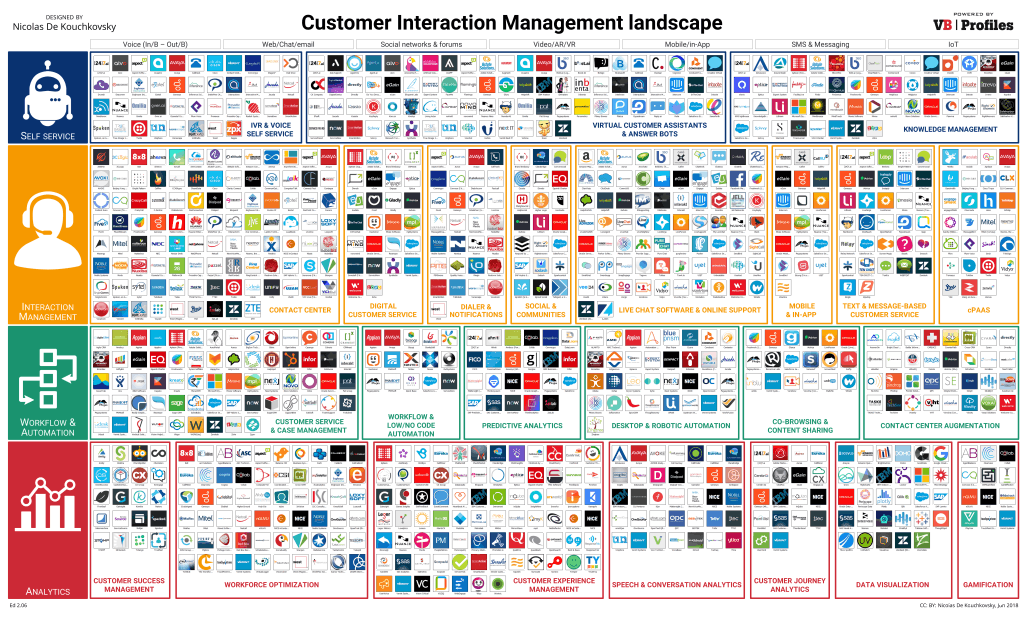Ready to learn Marketing & Customer Analytics Training? Browse courses like Increase Cross Selling and Upselling of Products and Services developed by industry thought leaders and Experfy in Harvard Innovation Lab.
The Customer Experience (CX) imperative has reshaped the landscape. It is impacting many parts of organizations and interaction management investments are no longer limited to customer service departments. Also, enterprises are looking at how they interact with customers in a more holistic way. It includes the resolution of the issues that triggered customers reaching out in the first place as well as providing proactive service.
The cloud transition accelerates
The transition to the cloud of contact centers has created a “gold rush” in a market where incumbent vendors had traditionally a leg up. I am now counting over 100 providers.
First movers Five9 and NICE InContact were joined by fast-follower Genesys with its Interactive Intelligence (ININ) acquisition and are the leaders after the first innings. We are still in the early stages of the migration though. I estimate the combined cloud revenues of these three companies, excluding telecom, to have crossed the $600 Million mark in 2017. It remains a small fraction of the overall market. They are now facing intense competition on many fronts.
The last 12 months saw all legacy vendors embracing the cloud and putting together their own offers. After OEMing Bright Pattern, Aspectintroduced its own solution, Avaya purchased Spoken Communications, and Cisco adopted the Transera technology as its go-forward solution after acquiring Broadsoft.
Two major disruptors broke into the market. Amazon introduced its Connect solution a little more than a year ago. Already a provider to several call center vendors with its APIs, Twilio moved one step deeper into the space with the launch of its own programmable contact center solution, Flex.
UCaaS providers are also joining the party. After buying Contactual a few years ago, 8×8 has combined its communications and contact center applications into a single solution. Fuze, RingCentral, and Vonage are reselling NICE In Contact while building their own capabilities.
Several CRM providers serving small and midsize businesses have been expanding their suite. Zendesk and Freshdesk have built call center products using Twilio. Others including Salesforce, ServiceNow, and Zoho provide digital customer service solutions that can be extended to voice either using Twilio or by exposing APIs.
I don’t think the market can support so many participants. Vendors face several challenges. New entrants tend to underestimate the features each communication channel requires. As they expand their channel support, they find themselves spread thinly on the engineering front. Moreover, most vendors have pretty low margins. Unless well funded, they are finding themselves investment-constrained. All participants are engaged in a race to reach a critical size and go after larger, more profitable, contact center opportunities.
So far, all cloud players have pursued the same playbook. They entered the market from the bottom with voice-centric solutions and later have been moving upmarket. They did so by incrementally scaling their software and expanding supported channels. The strategy worked well with small and midsize contact centers. Indeed, they prefer single-vendor solutions and are ready to make compromises on features. It is also relatively easy for them to switch to a new solution after a short trial. The situation is very different at the top end of the market. Larger companies need a phased transition to maximize existing investments and cope with their more complex environments. They also expect to be able to customize their implementation. These requirements, along with larger scale deployments, will force vendors to modernize their architecture, adding to their engineering burden.
We should expect more mergers and acquisitions and some players retrenching into niches.
Going omnichannel and digital
Vendors on all fronts made omnichannel support a key priority. If you put aside a handful of call center vendors that chose to stay focused on voice and new entrants, most support at least email and chat in addition to voice. Social and messaging channel specialists such as Brand Embassy, Dimelo, InTheChat, or Sparkcentral have become digital customer service providers. Several CRM players have been adding omnichannel routing capabilities to their suite.
The industry has embraced the vision of enabling customers to contact businesses on the channel of their choice and be able to switch transparently from one to another. However, this vision is not easy to implement. It assumes “universal” agents able to handle all channels. For many organizations, in particular the largest ones, the implied human transformation can be daunting. In some cases, it can be undesirable. Indeed, many organizations are finding agent specialization between voice or digital channels preferable.
A growing number of enterprises are pursuing their transition to omnichannel in a more selective way. They are charting their path forward by picking a specific customer experience and optimizing it for and with digital technologies. It may entail channel switching but in a more manageable manner. The approach makes also the preservation of existing channel specific–features and service levels simpler. It goes beyond optimizing just interactions and aims at making the entire end-to-end experience fluid and expedited, leveraging all the new possibilities of the digital world.
This adoption pattern has driven a renewed interest in workflow capabilities as well as low and or no-code digital automation platforms. These technologies allow the orchestration of all the steps of a customer journey, encompassing both interactions and transactions with applications. Avaya built these capabilities into its latest Oceana platform. They can also be found in the latest technology iterations of business processes management providers like Appian or Pegasystems.
The focus on specific use cases and the customer journey has also opened the door to new models blending together self and live service across several channels such as the ones proposed by Intercom or Front.
Context is king
The pursuit of fluid experiences is reinforcing the role of context. Traditional approaches consist in either using the CRM system of record as the repository for the customer context or relying on the interaction management platform to link together related interactions. Several new entrants including Bright Pattern, Gladly, or Kustomer are building into their platform the ability to put together rich context by pulling information from different applications and combining it with interactions data. Indeed the customer context is often spread over multiple applications. Context assembly is not new. It was actually pioneered by Genesys when it introduced its Conversation Manager in 2010. What is new is the degree of packaging of these solutions and the possibilities of cloud-based integration.
In the second part of this article, I will continue my exploration of the key trends impacting the market. Stay tuned!




